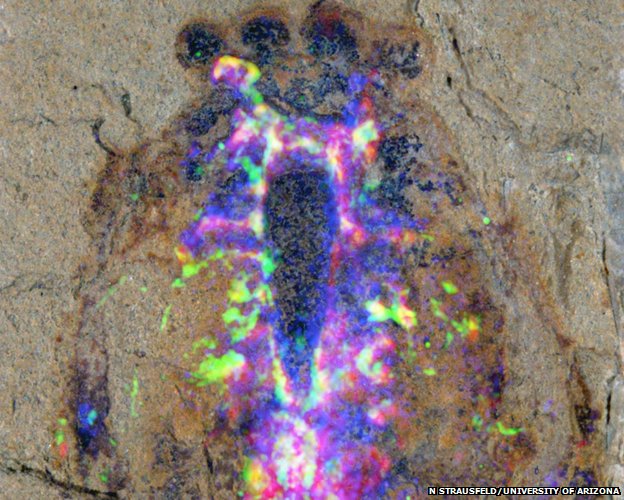
Scientists have discovered the best-preserved nervous system in an ancient fossil.
Dating back 520 million years, the clawed spider-like fossil shows clear evidence of a brain and of nerve cords running through the creature's trunk.
 The specimen now confirms that the ancestors of spiders and scorpions were related, but branched off more than half-a-billion years ago.
The specimen now confirms that the ancestors of spiders and scorpions were related, but branched off more than half-a-billion years ago.
A team of international scientists present their work in Nature.
The "great appendage" arthropods, are an extinct group of joint-legged creatures with large claw-like appendages - or growths - protruding from their heads.
The nervous system tends to be similar between major groups of animals, which helps palaeontologists work out how they are related, explained Greg Edgecombe from the Natural History Museum in London.
"The nervous system is one of the more reliable tool-kits we have. We were trying to investigate whether there was evidence for the preservation of neural tissues from very early parts of the animal fossil record," he told BBC News.
"What we've been working with is fossils with very fine anatomical preservation from the Cambrian period. These have given us information about brains, the nerve cords and the neural tissue that goes into the eyes."
New to science, the fossil was recently discovered in South China and is part of the genus Alalcomenaeus. This group had segmented bodies equipped with about a dozen pairs of appendages which enabled the creatures to swim or crawl.
It was placed in a CT scanner and compared with other arthropods in order to understand its evolution. The team then used 3D software to see structures not visible on the surface of the fossil.
"People like myself who are mad keen on creepy crawlies want to understand how very strange early arthropods relate to living ones," added Dr Edgecombe.
"By having access to the nervous system it allows us to study the evolutionary relationships of very ancient fossils using the same kind of information that we would use for living animals."
Co-author, Xiaoya Ma, also from the Natural History Museum, said: "It is very exciting to use new techniques to successfully reveal such a complete central nervous system from a 520-million-year old fossil, and in such detail."
She told the BBC's Science in Action programme that the high resolution of the reconstructed image allowed the team to see "the concentrated neural structures in the head region". They could also observe the segments of the brain associated with the claw-like appendages.
The fossil belongs to an extinct group of marine arthropods known as megacheirans, Greek for "large claws".
To infer the evolutionary relationships between species, the fields of palaeontology and neuroanatomy together.
Nicholas Strausfeld was from the anatomy side of the team at the University of Arizona, US.
"We now know that the megacheirans had central nervous systems very similar to today's horseshoe crabs and scorpions," said Prof Strausfeld.
"This means the ancestors of spiders and their kin lived side by side with the ancestors of crustaceans in the Lower Cambrian."
He added that their prominent appendages were clearly used for grasping and holding.
"Based on their location, we can now say that the biting mouthparts in spiders and their relatives evolved from these appendages."
The team says they expect to find more fossils dating even further back, which will shed new light onto the ancestors of many of today's arthropods.

 Previous page
Previous page Back to top
Back to top







